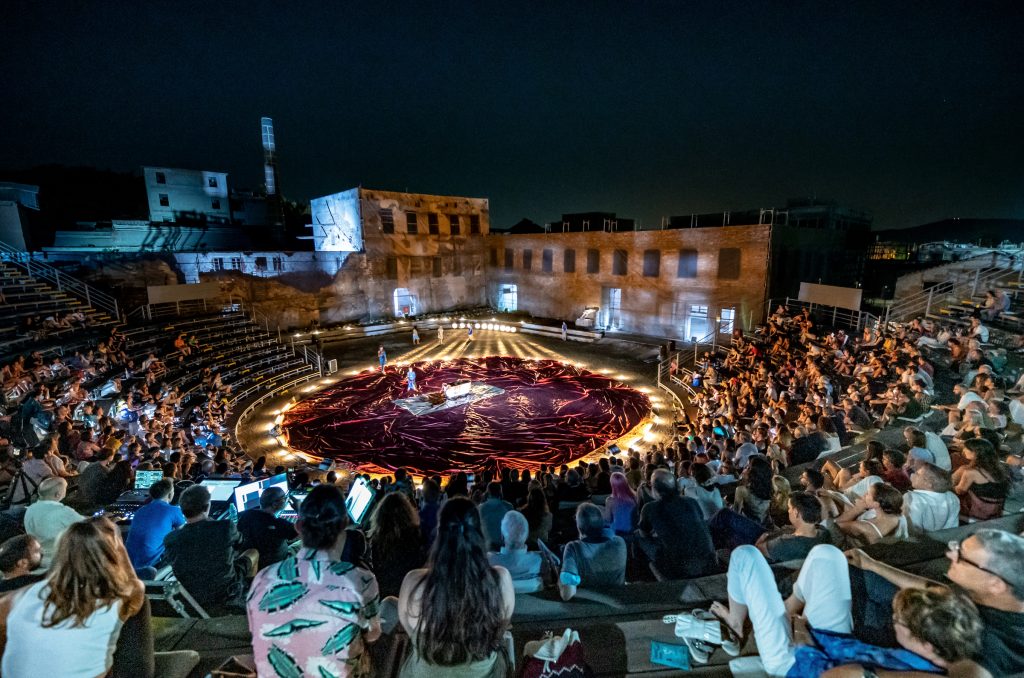ELEFSINA, Greece – Every few minutes at the newly reopened Eleusis Archaeological Museum, visitors receive a divine revelation. In a darkened room, the seven-foot-tall “Great Eleusinian Relief” (440-30 Ka) is a monstrous depiction of the Greek goddesses Demeter and Persephone imparting the secrets of agriculture to mortals. Suddenly, a rising wave of brilliant white Light from an LED panel floods the room, a curatorial interpretation of Plato’s description of the visual revelation that once took place here – Ancient Greece Meets James Turrell.
Eleusis, half an hour’s drive from Athens and now known as the city of Elefsina, was the heart of the cult of Demeter and Persephone in ancient Greece. During antiquity, the site was made into a panhellenic religion for the “Eleusinian Mysteries”, where Athenian devotees would go to Eleusis in the initiatory cult, hoping that the rites performed there would grant them an afterlife. Until now, the popular theory that hallucinogenic mushrooms were mixed in the ritual drink kykeon it has been largely disproven. Perhaps the core of the power of mystery was simply the power of religious theater. The initiates took care of that enigmatic ceremony so well that Ka II. It was not until the 16th century that a Christian writer was said to reveal the secret formulas of this ancient pagan tradition.

Despite its legendary status in ancient Greece, the city was hit hard by the industrialization of the 20th century. Paint and steel production, oil refining and industrial transport heavily polluted the water and air around the city. Mid-century photographs show stacks of smoke appearing behind scattered pieces of marble. In 2005, Elefsina, a city of blocky cement houses and overgrown sidewalks, was identified as “of major environmental concern” by the European Environment Association. Today, the rusting skeletons of industrial ships still litter the beach of Vlycha.
In 2023, the reopening of the site’s archaeological museum after a major renovation coincided with Elefsina’s designation as European Capital of Culture (ECoC), for which Eleusis 2023 organized an ambitious contemporary art exhibition and performance exploring the city’s past. The mysteries of transition. Now, Elefsina is faced with a new mystery: what happens next? Can contemporary art harness history to revitalize an economically and ecologically struggling city?

Mysteries of Transition Eleusis 2023 was directed by Director General Soultana Spyropoulou and Chief Artistic Director Michail Marmarinos. Millions of euros were invested in the project, including large contributions from HELLENiQ Energy Holdings and Titan Cement, both of which operate facilities in Elefsin. HELLENiQ is the former Hellenic Petroleum, a once state-owned oil refinery that produced much of the oil spilled into the Saronic Gulf in a 2017 incident. The irony of HELLENiQ’s sponsorship in particular is hard to miss. But both Eleusis 2023 and HELLENiQ’s press releases about the company’s involvement avoid acknowledging the company’s historic relationship with the people and environment of the Saronic Gulf.
However, the history of Elefsina, both ancient and modern, was the central theme of the Mysteries of Transition. The opening ceremony explored the relationship between ancient Eleusis and industrial Elefsina through a procession from Athens to Eleusis and the release of a large mechanical whale from the harbor. To host an extensive program of art shows and live performances, known as “mysteries”, former industrial spaces were converted into galleries, cinemas and performance halls. These venues, which can continue to attract artists and tourists, play a key role in Eleusis 2023’s hopes for the future. Looking to that future in stark language, Marmarinos stated that the true payoff of Elefsina’s year as ECoC would be “her afterlife.”

Nearby Athens, with its increasingly international art scene, offers a window into what this afterlife might be like. After Documenta 14 in 2017, Athens’ contemporary art scene was poised to become the center of the global art community. This has taken real shape, particularly in spaces like the Breeder Gallery. When the gallery opened a physical space in a renovated ice cream factory in Metaxourgeio in 2019, it seemed to mark the beginning of the neighborhood’s revitalization. Metaxourgeio has historically welcomed migrant communities, but has also struggled with high rates of drug addiction. Despite the expansion of the grower community, the presence of the gallery has coincided with the increase in real estate prices, without improving the challenges that faced the neighborhood. In response, the residents of Metaxourgeio held a funeral for their neighborhood last March.
Thousands of years ago, the Eleusinian Mysteries helped initiates make sense of their relationship with the more-than-human world. In the coming years, it is very possible that the new art infrastructure of Elefsina will attract more tourists and artists to the city, facing the shortage of human and financial resources that the City Council of Elefsina has identified as the main challenge for the development and implementation of environmental policy. Some self-assessment workshops are aimed at laying the foundations for a long-term strategy. But until a clearer plan emerges to turn art into action, Elefsina’s reign as European Capital of Culture risks romanticizing the city’s ancient history and aestheticizing its current environmental disaster and economic hardship.


